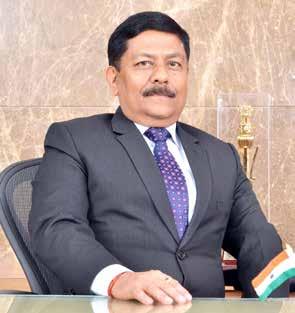
74 minute read
BDL : India’s Stellar Megahit
Commodore (Retd) Siddharth Mishra
Chairman and Managing Director, BDL Bharat Dynamics Limited (BDL) has emerged as a global leader in aerospace and underwater weapons manufacturing industry. The sole manufacturer of guided missile systems and allied equipment in India, BDL is the Weapon System Integrator that provides a complete solution to the Indian Armed Forces. BDL is now poised to expand its operations beyond transnational horizons across the Indian Ocean Region, joining hands with OEMs to set up defence manufacturing facilities for friendly nations among the Indian Ocean Rim Association, to produce missile weapon systems. Commodore (Retd) Siddharth Mishra, BDL Chairman and Managing Director, in an interview with Aeromag speaks about the operations of the company and expansion plans. Excerpts from the interview.
Advertisement
Bharat Dynamics Ltd and Thales have signed an agreement to manufacture the STARStreak Air Defence System in India. Could you share more details of the partnership?
BDL and Thales have signed a Teaming Agreement to work in partnership on the STARStreak Air Defence System with the support of both the Governments of India and the United Kingdom. Through this agreement, BDL will become a part of the STARStreak global supply chain, providing the opportunity for export of the system to existing and future STARStreak Air Defence customers, including the UK Armed Forces.
Partnership between Thales and BDL in this project with Transfer of Technology (ToT) for STARStreak will create a new business opportunity for BDL and its Supply Chain Partners in India. BDL will be able to expand its footprints in the export market in addition to domestic market with this new business opportunity. The ‘Make in India’ programme, the ‘ease of doing business’ and recent ‘Atmanirbhar Bharat’ initiatives have created a congenial ecosystem for the foreign OEMs to tie up with Indian companies like BDL to establish production facilities in India.
The agreement will also provide opportunity for BDL to offer STARStreak missile system to the Indian Armed Forces with a minimum of 60% of indigenous content, as well as Design and Development of the system, qualifying it under the ‘Make in India’ programme.
BDL crossed a major milestone in 2020 when the company handed over the first production Varunastra heavyweight torpedo to the Indian Navy. Could you elaborate on the torpedo projects?
BDL has built a wide array of underwater weapons such as Torpedoes and Decoys, and Electronic warfare Counter Measure Dispensing Systems. Varunastra, the Heavy Weight Torpedo, is designed and developed by Naval Science and Technological Laboratory, Visakhapatnam. BDL, being the production agency, is manufacturing Varunastra at its Visakhapatnam Unit for the Indian Navy.
The first Varunastra, being delivered to the Indian Navy, was flagged off by the Secretary, Department of Defence R&D and Chairman, DRDO recently. This product is also being offered for export.
With a variable speed facility at 20 and 40 knots, Varunastra is capable of targeting quiet, anechoic submarines operating in shallow or deep waters in an intense acoustic countermeasure environment. It can be fired from all ASW ships capable of firing heavyweight torpedoes.
Besides, Varunastra, BDL has developed TAL, the Light-Weight Torpedo. It is the first indigenous torpedo of India which can be launched from ship, helicopters and submarines. BDL is also the co-development partner of DRDO for several of its upcoming projects under categories such as MIGM, Advance/ Extended Range Heavy Weight Torpedo.
Another significant event involving the BDL in 2020 was the unveiling of the Amogha-III anti-tank guided missile (ATGM). Could you update us on the ATGM
project?
Amogha – III has been designed and developed by BDL with the support of DRDO. It is a Third Generation fire-and-forget Anti-Tank Guided Missile with Dual mode IIR Seeker having a range of 200 to 2,500 mtrs. Equipped with a Tandem warhead, Amogha III has a Top/direct attack mode and is Man portable. It will be commercialized after successful completion of user trials. Amogha – III, being one of the best in its class of missiles, will be able to meet not only the requirements of the Indian Armed Forces but also friendly foreign countries.
BDL has made significant contributions to India’s indigenisation efforts and latest examples are the launch of Konkurs missile test equipment and Konkurs launcher test equipment. Can you tell us more about these and other indigenisation projects by BDL?
BDL has been working relentlessly to contribute towards creation of ‘Atmanirbhar Bharat’ in the area of Defence. BDL has also indigenised a few components and sub-assemblies of ATGMs and Underwater Weapons, which were being imported by the company. During August last year, Hon’ble Raksha Mantri issued the ‘Expression of Interest’ for these components and sub-assemblies.
Among the various policies announced by the Government in Defence sector, the creation of negative list of imports will also help develop the defence manufacturing sector. In this direction, BDL has successfully achieved significant levels of indigenisation for the “all-time import items” of the weapon systems being currently supplied to the Indian Army. BDL is also offering various items for indigenisation of various missiles to the industry including MSMEs.
The company is also extending its technical support to its vendors including test facilities available with BDL. The procedures have been streamlined to encourage active participation of startups.
India is planning to achieve a defence export target of Rs 35,000 crore by 2025. What plans have been charted out by BDL to meet the target? Which countries are likely to be BDL’s potential customers in future?
BDL is poised to take on the manufacture of futuristic weapon systems. Towards this, BDL team is committed to hone new skills and create necessary infrastructure. Given the export potential and demand for its products, BDL has forayed into international market by offering its exportable products to foreign countries. It is already executing an export order of torpedoes and with the recent announcement from the Government of India regarding clearance of Akash Weapon System for Export, BDL is geared up to take up export orders for the Akash Weapon System.
BDL has been showcasing its unique array of exportable products, accessible to friendly nations among the IORA sub-regional entities who share common security and regional concerns with India. BDL is well-equipped as a global player in aerospace and underwater weapons manufacturing industry to contribute substantially to boost India’s leverage and decisive role in responding to the growing Maritime Security challenges in the Indian Ocean Region and offering defence platform capabilities for peace, security, stability and credible deterrence to the friendly nations.
BDL will be offering the IOR nations viable, costeffective and cutting edge solutions, niche technologies and emerging platforms of guided missile systems and underwater weapons.
The New Year has brought hope all around. What are BDL’s major plans for 2021? Are any new products in the pipeline?
BDL, as a part of its Global Outreach, is endeavouring to forge alliance with foreign companies to take the ‘Make in India’ mission further. BDL proposes to set up manufacturing facilities abroad in partnership with OEMs for mutual benefit, which can be offsets emerging out of contracts, co-development programmes, outsourcing etc. Thrust is on exploring tieups with the IOR littoral nations for launching projects for developing new missiles and underwater weapons and potential Transfer of Technology, primarily for the benefit of IORA entities.
BDL has planned for launch of new products during Aero India – 2021. BDL is also entering into MoU with foreign and domestic companies during the airshow which would set the tone for new accomplishments for the organisation in future. The Company is also creating a Seeker Facility Centre and Warhead production facility at its premises.
Nag, manufactured by BDL, also completed its final trial in 2020. Could you share with us details of the project? Also can you talk about the latest developments regarding MRSAM?
Nag is a third-generation fire-and-forget mechanised infantry ATGM with top attack capability to destroy armoured vehicle equipped with explosive reactive armour. The final trials of NAG were held recently. BDL will be commencing its production in the near future.
The Medium Range Surface to Air Missile or MRSAM is designed and developed by DRDO and IAI, Israel. BDL is the production agency for it. It is a high response, quick reaction, vertically launched supersonic missile with a range of 70 kms. The Missile is designed to neutralize enemy aerial threats like missiles, aircraft and helicopters.

TDF Aims to Broaden Defence Supply Chain
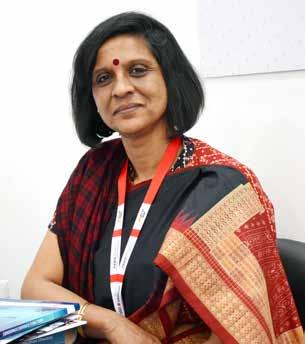
Nidhi Bansal
Scientist G, & Director, TDF, Directorate of TDF, DRDO “The Indian Private Industry in Defence and Aerospace Sector is a base which we need to broaden. We have very capable private industries with us, but perhaps because of the barriers they face in entering into defence sector, most of them have not been able to come into the supply sector of the defence manufacturing. So, with schemes like TDF under the Abhiyan of Make in India, we aim to bring more industries especially MSMEs and Startups in the supply chain of our defence and military technologies. They are highly capable and need to come under the defence ecosystem completely,” said Nidhi Bansal, Scientist G, and Director, Technology Development Fund (TDF), Directorate of TDF, DRDO. In an interview with Aeromag, Nidhi Bansal talks about TDF’s operations and initiatives in promoting technology application in defence.
Technology Development Fund (TDF) has been established to encourage participation of public/ private industries especially MSMEs and create an ecosystem for enhancing cutting edge technology capability for defence application. How successful has been TDF in achieving the objectives?
The scheme was announced in September 2016 however, the first batch of projects was rolled out in January 2018. We were awarded three projects in January 2018, and I am very happy to say that out of those three, one was successfully completed already. The other two will also be completed soon.
Further, we have been awarded a total of 25 projects till date. These projects have a maximum completion time of 24 months. Last year, during the COVID – 19 pandemic, we were awarded 19 projects over a short span of nine months.
For each project, we have a sealing of Rs.10 crore, out of which a maximum of 90% is funded by DRDO as grant-in-aid. Around Rs.150 crores has already been allocated to 25 awarded projects till date. Presently, we are working on more than 100 projects, which are at different phases of getting awarded to us.
Usually, we get the requirements from Ministry of Defence (MoD), ADA, Tri-Services (Army, Navy, Air Force), Department of Defence Production and DRDO. The projects which are found feasible under the scope of TDF Scheme will be taken up for funding.
How do you assess the potential of India’s private industry in defence and aerospace sector? How does TDF increase their participation in the mainstream manufacturing Sector?
The Indian Private Industry in Defence and Aerospace Sector is a base which we need to broaden. We have very capable private industries with us, but perhaps because of the barriers they face in entering into defence sector, most of them have not been able to come into the supply sector of the defence manufacturing. So, with schemes like TDF under the Abhiyan of Make in India, we aim to bring more industries especially MSMEs and Startups in the supply chain of our defence and military technologies. They are highly capable and need to come under the defence ecosystem completely.
How does TDF promote import substitution of components whose technologies does not exist with
the Indian Industry? What are the latest activities in this regard?
Primarily, TDF is aimed at developing technologies within India. It is looking at the technologies which we have not been indigenized till date or the technologies that have futuristic usage. We are looking at the industries which are owned by resident Indians. At least 51% company shares should be with the resident Indians and we are looking only at indigenized technologies. We are not looking at anything you buy from abroad. It must be developed within country.
TDF is working on the requirements which we are getting from the users. We are not only providing funds to the industry, but also technically helping and mentoring them. DRDO is also allowing the industry to test their products at its test facilities. We are bringing certified agencies to support them. We are also sharing our knowledge with them hoping that they will be able to develop those technologies and be
What are the challenges faced in the indigenization of defence manufacturing sector in India? How does TDF plan to tackle them?
In our view, the private industries especially MSMEs and Start-ups are very capable and very proficient. We are hoping that with the kind of handholding that DRDO and TDF are doing, we should be able to meet all their challenge and bring them into the fall of business supply.
What are TDF’s activities to support Atma Nirbhar Bharat?
TDF itself is the brainchild of Atma Nirbhar Bharat Initiative. It is completely working towards achieving that. It is a MoD Scheme which is being executed by DRDO under Make in India initiative of Govt of India.
Navy, Suryadipta sign contract for ACTCM Barges

Indian Navy has signed a contract for construction & delivery of Eleven Ammunition Cum Torpedo Cum Missile (ACTCM) Barges with Suryadipta Projects Private Limited, a Thane based MSME company.
Delivery of Barges is scheduled to commence from May 2022. The Ammunition Cum Torpedo Cum Missile Barges will be inducted in Indian Navy to undertake the mission needs for embarking/ disembarking Ammunition, Torpedo & Missile etc. These barges will be built under the Classification Rules of Indian Register of Shipping (IRS). The project is another milestone to the Atmanirbhar Bharat & Make in India initiative of the Government of India.
India hikes defence budget; stress on modernization
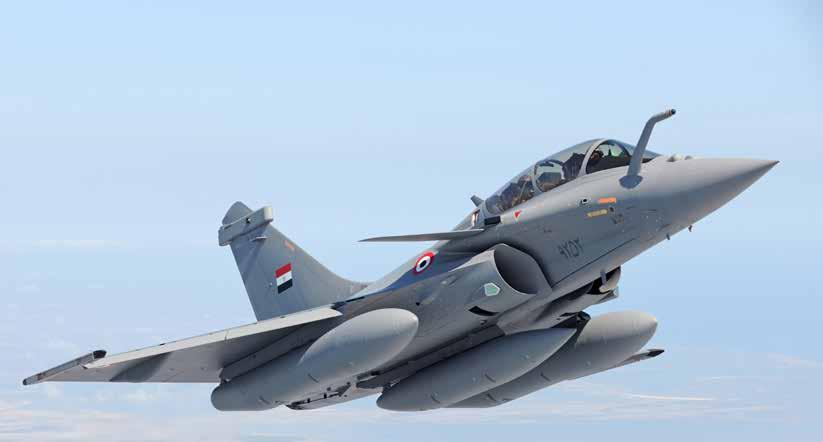
The Defence forces have been allotted Rs 4.78 lakh crore in the Budget for 2021-22 presented by Finance Minister Nirmala Sitharaman, registering an increase of 1.4% over last year. Earlier, the Ministry of Defence eased procedures for procurement from aerospace and defence firms and vendors
The Indian Government’s budget for 2021-22 has allocated an amount of Rs 4.78 lakh crore to the Defence services, which is 1.4% more than the Rs 4.71 lakh crore earmarked in the 202021 budget. However, there was a nearly 19% rise in capital outlay for military modernisation in 202021 and an additional unbudgeted Rs 20,776 crore was spent to buy military hardware considering the tensions on the Chinese border.
The revised capital expenditure for 2020-21 was pegged at Rs 1,34,510 crore as against last year’s budgetary allocation of Rs 1,13,734 crore to reflect the additional expenses. The Indian armed forces procured ammunition and weapons from several countries in the last few months following the military face-off with China that erupted in May 2020.
According to the documents presented by Finance Minister Nirmala Sitharaman in Parliament, a total of Rs 1,35,060 crore has been set aside for capital expenditure that includes purchasing new weapons,

aircraft, warships and other military hardware. The capital outlay for 2021-22 is an increase of 18.75% compared to last year’s allocation of Rs 1,13,734 crore.
In a tweet, Defence Minister Rajnath Singh thanked Prime Minister Narendra Modi and Sitharaman for increasing the defence budget to Rs 4,78,195 crore, and said the nearly 19% hike in the capital expenditure is the “highest ever” increase in the last 15 years. The defence minister also expressed happiness over Sitharaman’s budget proposal to open 100 new Sainik schools.
The Rs 4.78 lakh crore budgetary outlay included an allocation of Rs 1.15 lakh crore for payment of pensions. Incidentally, this amount has come down as it was Rs 1.33 lakh crore in the previous budget. Officials later clarified that the allocation was more in 2020-21 as approximately Rs 18,000 crore was to be paid on account of pension arrears.
Excluding the pension outgo, the total revenue expenditure, which includes expenses on payment of salaries and maintenance of establishments, has been pegged at Rs 2.12 lakh crore.
Defence experts said the allocations were satisfactory considering the state of the economy in view of the impact of the coronavirus pandemic. The increase of around Rs 22,000 crore in capital outlay is a welcome move which will help the three services in carrying out with their modernisation drive, they added.
In the budget, the Army has been granted a capital outlay of Rs 36,481 crore as against Rs 33,213 crore in 2020-21, as per the revised estimates. The allocation made to the Navy for capital expenditure is Rs 33,253 crore which was Rs 37,542 crore in the previous budget. Similarly, the Indian Air Force (IAF) has been given Rs 53,214 crore to buy new platforms and weapons which is a drop of Rs 1,840 crore compared to the money it spent under capital expenditure in 2020-21. The budgetary capital outlay for the IAF for 2020-21 was Rs 43,281.91 crore but the revised estimate put the figure at Rs 55,055 crore.
Allocations for DRDO, BRO
The capital allocation for the Defence Research and Development Organisation (DRDO) has been pegged at Rs 11,375 crore which is an increase of 8% over the amount earmarked in 2020-21. The allocation for Border Roads Organisation (BRO) has been increased to Rs 6,004 crore which is 7.48% more than the amount given in 2021-22.
The Defence budget comes to around 1.63% of the GDP.
SOP amended
Meanwhile, the Directorate General of Aeronautical Quality Assurance (DGAQA) under the Ministry of Defence has recently carried out a review of the Standard Operating Procedure (SOP) for assessment and registration of the firms and vendors supplying airborne materials / stores.
The new rules are intended to bring out more clarity in respect of various aspects like methods for registration fee payment, NIC mail ID-based Central Public Procurement (CPP) portal registration and to simplify and streamline the registration application, assessment report and other procedures.
The firms intending to provide their services for design, development, production, overhaul/servicing and maintenance of military aviation stores can now follow this SOP.
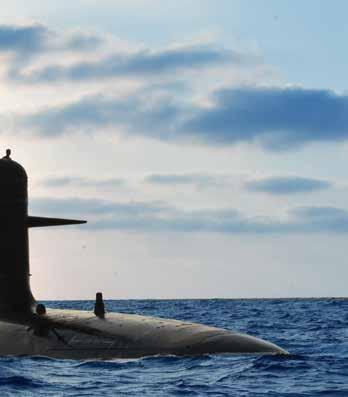






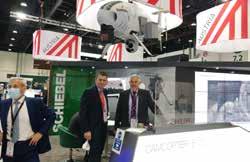
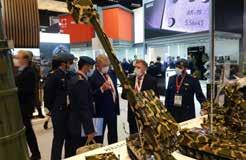
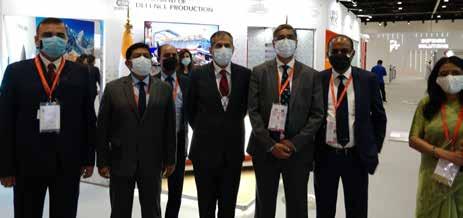

IDEX 2021:
The 15th edition of the International Defence Exhibition (IDEX) and the Naval Defence Exhibition (NAVDEX) has been concluded by the Higher Organising Committee for the exhibitions. The five-day events have seen extensive local and an exceptional edition international participation. The central success of the 15th edition lies in that it was the first global defence event to take place in the with over visitors 62,000 post pandemic recovery stage, with 62,445 attendees at the venue across five days. 900 exhibitors, 59 countries, and 35 international pavilions participated in IDEX and NAVDEX 2021, alongside five countries participating in the exhibitions for the first time: Israel, North Macedonia, Luxembourg, Portugal, and Azerbaijan. AED 20.957 billion (USD 5.7 billion) worth of deals were signed by the UAE Armed Forces during IDEX and NAVDEX 2021. Five deals with international companies
and 15 with local companies were inked on the final day of the exhibitions, at a value of AED 904.2 million (USD 246.2 million).
The committee announced the conclusion of the two exhibitions during a press conference held today (Thursday) at the Abu Dhabi National Exhibition Center, in the presence of His Excellency Major General Pilot Faris Khalaf Al Mazrouei, Commander-inChief of Abu Dhabi Police, Chairman of the Higher Organizing Committee for "IDEX" and "NAVDEX" exhibitions, and His Excellency Major General Staff Pilot Ishaq Saleh Muhammad Al Balushi, Assistant Undersecretary for Industries and Development of Defense Capabilities at the Ministry of Defense, Vice Chairman of the Supreme Committee, and Humaid Matar Al Dhaheri, Managing Director and CEO of Abu Dhabi National Exhibitions Company "ADNEC" and its group of companies.
Commenting on the conclusion of the exhibitions, His Excellency Major General Staff Pilot Faris Khalaf Al Mazrouei, Chairman of the Higher Organising Committee, said: “The 15th edition of the IDEX and NAVDEX exhibitions has been nothing short of exceptional. These events continue to strengthen their global position, providing exhibitors and participants from around the world with an integrated global platform, in spite of the challenges imposed by the COVID-19 pandemic. IDEX and NAVDEX drive and enable innovation, in line with the rapid development of the fourth industrial revolution.
“The success of these exhibitions has been rooted in the stalwart and visionary support of our wise leadership. Their confidence in our ability to host the world, here in Abu Dhabi, has been critical to the wider realisation of this edition.
“Today marks a new chapter in pre-eminence. 2021 is the Golden Jubilee Year is the Golden Jubilee of the foundation of the United Arab Emirates. That union has enabled our nation to cultivate and expand our defence infrastructure and technological systems, using them to ensure security and peace across the Middle East.
“The foremost achievement of this edition of the exhibitions was the stringent and rigorous implementation of all precautionary measures across ADNEC, preserving the health and safety of all participants, exhibitors, and visitors. IDEX and NAVDEX 2021 enabled the return of the national business tourism sector, alongside continuing to support the UAE’s defence industry. These exhibitions ensure that UAE products are globally competitively, both meeting the needs of the nation alongside reaching new markets.”
Concluding, His Excellency said: “The contributions of a range of stakeholders to enable the success of this event has been immense. Media professionals, organisers, strategic partners, and subcommittees have each played a significant role in bringing this event to life. Finally, we must recognise the contribution of frontline workers, who were at the event for each moment. Their efforts ensured the safety of all attendees, in line with the vision of the government of the UAE.”
His Excellency Staff Pilot Ishaq Saleh Al Balushi, Head of the Executive Directorate of Industries and Development of Defense Capabilities at the Ministry of Defense, and Vice Chairman of the Higher Organising Committee for IDEX and NAVDEX, commented: “The UAE has once again demonstrated its global leadership in hosting and organising international and strategic events. These events indicate renewed confidence and optimism as the UAE charts a new course for post-pandemic recovery.
“Our nation’s wise leadership, having extensively examined a range of analyses, decided to host the 15th Edition. To adhere to this decision, given the exceptional global circumstances, we implemented a strategic direction different from previous editions of the exhibition, with a refreshed set of standards.
“Hosting over 110 international delegations, comprised of decision-makers, investors, and senior executives, demonstrates the confidence of the global community in the United Arab Emirates. Furthermore, it exhibits how defence remains an internationally critical sector, and how the industry is strengthened by strategic partnerships and deal signings which shape the industry’s future.
“2021 has seen the UAE Armed Forces sign the highest value of deals during the exhibitions’ histories. The brokerage of such agreements plays a pivotal role in devising and implementing long-term security and defence strategies, and ensuring the adoption of optimal solutions to face future challenges, given the fourth industrial revolution.”
Humaid Matar Al Dhaheri, Managing Director and Group CEO of the Abu Dhabi National Exhibitions Company, commented: “Today brings an end to an edition which was described as one of the most successful global events organised in the post pandemic phase by participants, exhibitors, and visitors alike. In organising these two exhibitions, we have met and exceeded the aspirations of all attending this edition.
“96% of visitors and exhibitors to IDEX and NAVDEX were satisfied with the exhibition, which is considered one of the highest rates in the global exhibition and conference sector. The wide range of precautionary protocols which ADNEC rigorously implemented across its infrastructure also met the approval of those visiting IDEX and NAVDEX, as well as specialists in the exhibition and conference sector.
“During the first four days of the exhibitions, 98% of participants and visitors shared that they were satisfied with the preventative and precautionary measures implemented, while 99% of participants stated they felt safe inside ADNEC. Doubtlessly, these figures demonstrate the accomplishment of this year of IDEX and NAVDEX. Lessons learnt here will support the wider resurgence of the business tourism sector, both at a local and international level.
“Across the five days, IDEX and NAVDEX attracted with 62,445 visitors from across the world. Such numbers demonstrate how exhibitors focus on specialised international events. It is a source of deep pride that we have been able to welcome the world, once again.”


Lt Gen T S A Narayanan Comdt MCEME & Col Comdt EME Army , Rajinder Singh Bhatia President and CEO of BFL Defence, Dr. Dasharath Ram DIR DRDL, Air Marshal I P Vipin COMDT AFA, M S R Prasad DS & DG MSS DRDO, Cmde Siddharth Mishra (Retd) Chairman & MD BDL, B H V S Narayana Murthy Director, RCI, DRDO and Brig Gen Pinhas Yungman Exec VM-AMDS DIV DIR RAFAEL,in Hyderabad during the first delivery of 1000 MRSAM missile kits for the Indian Army and Airforce.
KRAS rolls out the first delivery of 1000 MRSAM Missile Kits for the Indian Army & Air Force
A significant milestone in defence space in line with PM vision of ‘Atmanirbharta’ Hyderabad facility will provide MRO service for the armed forces
Kalyani Rafael Advanced Systems Pvt Ltd. (KRAS). KRAS MSME- a joint venture between two global giants – India’s Kalyani Group, and Rafael Advanced Defense Systems of Israel rolls out its first batch of Medium Range Surface to Air Missile (MRSAM) for the Indian Army and the Air Force. All of this in consonance with the umbrella Make-in-India idea.
The roll-out event marked KRAS’ commitment to deliver more than 1000 MRSAM ‘missile kits’ for the Indian Army and Air Force over the coming years. These missile sections will then be ‘forwarded’ to India’s state-run defence miniratna Bharat Dynamics Limited (BDL) for further and future integration.
Also, the event designated the beginning of the journey of a MSME Indian company which is committed not only to the “Make-in-India” concept, but to, as well, taking its own stride towards the larger “Atmanirbharta” idea (self-reliance). In this effort the company has fused Rafael’s state-of the-art technology with the engineering excellence of the Kalyani Group.
The event was being attended by dignitaries from the Ministry of Defence, (MOD), Indian Army, Indian Air Force, DRDO, the BDL, and the Israeli delegation including EVP, Brig. Gen. (Res.) Pinhas (Pini) Yungman, Head of Air and Missile Defense Systems division of Rafael. The Kalyani delegation was being led by Mr Rajinder Bhatia, President and CEO of BFL Defence and also by representatives from the IAI, Israel.
Baba Kalyani, Chairman and Managing Director, Kalyani Group, said, “This is beginning of a new era, filled with self-confidence, a marked step-change in technological expertise and a collective demonstration of capability to be the global manufacturing hub for defence products. We are confident to complete the order far ahead of the stipulated time, and support the armed forces with the best in class missile kits. Apart from the missile kits, we will extend our support in Maintenance and Repair Operations (MRO) as in-service Air Defence Missile System for the armed forces.”
Speaking on the occasion, Brig. Gen. Pinhas Yungman, Head of Air and Missile Defense Systems division of Rafael Advanced Defense System said, “We have been a reliable partner to the Indian armed forces for almost three decades, and these missile kits are a testimony of our commitment to ‘Make in India’ cause. We are confident KRAS will not only build products for the Indian armed forces but will, at the same time, trigger and help achieve Indian government’s vision of exports from India.”
KRAS is India’s pioneering private sector MSME with advanced manufacturing capabilities and facilities dedicated to especially address the assembly, integration and testing (AIT) of the stateof the-art weapon systems being inducted by the defence forces. Parallel with manufacturing, KRAS is maturing to address Maintenance and Repair Operations (MRO) too, that of a major in-service Air Defence Missile System for the Indian Air Force. As part of its “Make-in-India” efforts, KRAS has also expanded its scope to include development of Advanced Defence Systems and Remotely-Controlled Weapon System.
The Joint Venture, thus, is a testament to the enhanced and deep cooperation between Israel and India in the strategic defence sector space, as the coming together leverages and conflates the technology of Rafael and engineering strength of the Kalyani Group.
DRDO hands over TOT for 14 technologies to 20 Industries
Defence Research and Development Organisation (DRDO) participated in the ‘Bandhan’ ceremony at Aero India 2021 to enhance cooperation and synergy between industry and Government organisations. Defence Minister Rajnath Singh, Chief of Defence Staff General Bipin Rawat, three Services Chiefs, Secretary Department of Defence R&D and Chairman DRDO Dr G Satheesh Reddy and Secretary (Defence Production) Raj Kumar along with other senior officials from Ministry of Defence & Karnataka Government and industrialists from entire country were present. The Transfer of Technologies (ToTs) were handed over in the presence of dignitaries, by the DRDO laboratories to the industry.
The DRDO handed over Licensing Agreements for ToT (LAToT) for 14 DRDO developed technologies to 20 industries. The technologies transferred are from the area of electronics, laser technology, armaments, life sciences, materials science, combat vehicles, naval systems, aeronautics, sensors, etc. The product technologies transferred are Low Level Transportable Radar (LLTR), Inertial Navigation System for Ship Application (INS-SA), Long Range Optical Target Locator (OTL 1500), Hand Held Through Wall Imaging Radar (HH-TWIR) and Commander TI (Thermal Imager) Sight for T-72 Tank are the sensor technologies transferred to various industries. NMRL-Fuel Cell based Air Independent Propulsion Technology for Naval Submarines named NMFCAIP is a unique capability developed by DRDO and now transferred to the industry. Multi Agent Robotic System (MARS) will be produced by Indian industry based on DRDO design.
Defence Minister said Bandhan exemplifies the spirit of ‘public-private partnership’. He added that the fountain head of any capability emerges from its foundation and the foundation of our vision rests on three pillars namely, research and development, public and private defence production and defence export. He mentioned that with an aim of encouraging the manufacture of defence related items in India, our endeavour will remain to bring down the defence imports by at least two billion dollars by 2022.
He also stated that the order of 83 Light Combat Aircraft (LCA) Tejas MK1 worth over Rs 48,000 crore will give a big boost to defence manufacturing especially to the aviation industry. He highlighted that the negative list of 108 items for import is also meant to provide opportunity to the domestic manufacturing sector to strengthen their base and contribute to Aatmanirbhar Bharat.
Many armament systems, namely 155 mm X 52 Cal Advance Towed Artillery Gun System (ATAGS), Mechanical Mine Layer - Self Propelled (MML– SP) and Prachand Anti-Tank Munition are handed over to the industry for production. Other technologies that are transferred today for production by Indian industry are Individual Under Water Breathing Apparatus (IUWBA), *Basic WhAP 8x8 & Addon Armour for WhAP and *4 MW Diesel Engine Infrared Signature Suppression System. An MoU was exchanged between DRDO and HAL to cooperate and finalize the aspects of ToTs of Uttam radar for new LCA configurations and new generation Radar Warning Receiver (RWR-NG).
These high technology products will provide impetus to Atmanirbhar Bharat drive of Govt. of India and boost the defence manufacturing sector with selfreliance and enhance the operation capabilities of Armed Forces.
Lufthansa Technik develops new onboard patient transport units
Lufthansa Technik AG recently began the strategic further development of its proven patient transport unit PTE (German: Patiententransporteinheit) for the air transport of patients in intensive medical care. Based on an order placed by the German Armed Forces in 2020, an initial 26 PTE NG (New Generation) units will be produced over the next two years. The further development for the German Armed Forces is based on the Patient Transport Unit (PTU) NG in international service, of which Lufthansa Technik recently delivered eight additional units to NATO's Multinational Multi Role Tanker Transport fleet. One goal of the further development is to make the PTE NG flexibly deployable on all suitable aircraft types of the German Armed Forces. To enable it to be used, for example, on both the Airbus A400M and the future Airbus A321neoLR of the German Air Force, it will receive all the necessary military and also civil approvals as both aviation and medical equipment.
LCA, Arjun
projects to give a fillip to Indian industry
Defence PSU Hindustan Aeronautics Limited (HAL) based in Bengaluru has received the clearance to produce 83 Light Combat Aircraft (LCA) of Tejas Mark-1A version after the Rs 46,898-crore order was signed following protracted discussions. According to HAL Chairman and Managing Director R Madhavan, the company will start delivering the first batch of aircraft in 36 months. HAL has been allotted nine years to complete the orders.
Currently, the company has the capacity to manufacture eight LCAs per year, which will be expanded to 16 after a second plant in Doddanekundi inaugurated by Defence Minister Rajnath Singh becomes operational.
Meanwhile, Rajnath Singh said several friendly countries had expressed interest in acquiring the Tejas. “We are expecting orders from those countries also,” he added.
The order for 83 aircraft includes 73 fighters and 10 trainers. The clearance was given by the Cabinet Committee on Security (CCS) in January, 2021. Officials said that the Tejas Mark-1A version will have 43 ‘improvements’ over the Tejas Mark1 jets which the Indian Air Force (IAF) had earlier ordered.

Benefits to industry
More than 500 Indian companies are collaborating with HAL on the project, providing a big thrust to the country’s indigenization efforts. In addition, as thousands of personnel are involved in these tasks, as many jobs are created. “Thanks to the LCA programme, around 50,000 persons have gained employment, directly and indirectly. The new orders are now expected to create at least 5,000 jobs more in the initial phase,” said a HAL official.
VEM technologies, L&T, DTL, Alpha Toccol, TAML, Data Patterns, Pendios and Compupower
India’s Ministry of Defence has cleared the proposals to build 83 light combat aircraft (LCA) for the Indian Air Force and 118 Arjun Mark-1A main-battle tanks for the Indian Army. In addition, several other acquisitions have been approved and in most of the projects private companies are involved. For instance, the LCA programme of HAL alone has the participation of around 500 other Indian firms
are among the private firms which have partnered with HAL on the project.
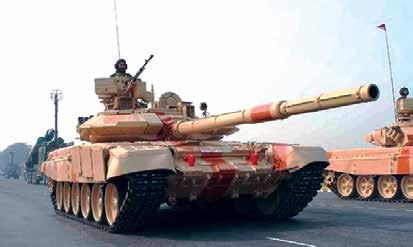
Arjun tank procurement
Another major order placed by India’s Ministry of Defence (MoD) recently involves the acquisition of 118 Arjun Mark-1A main-battle tanks for Rs 8,379 crore. This is the second biggest defence contract after the 83-jet Tejas contract.
The new 118 Arjuns have 71 upgrades over the 124 tanks inducted by the Indian Army over 10 years ago. In fact, the Mark-1A tanks come with better firepower, mobility, protection and endurance. The tanks will be built by the Heavy Vehicles Factory (HVF) at Avadi. HVF is planning to manufacture the first five Arjun Mark-1A tanks within 30 months. Once these tanks are approved, HVF will deliver 30 tanks a year.
Meanwhile, the DRDO has spent considerable time and effort to meet the requirements of the Army regarding the maintenance, spares and other issues of Arjun. The R&D organisation also carried out 14 major and 57 minor alterations in the Arjun Mark-1A tanks. One more upgrade would soon follow, which is the cannon-launched guided missile.
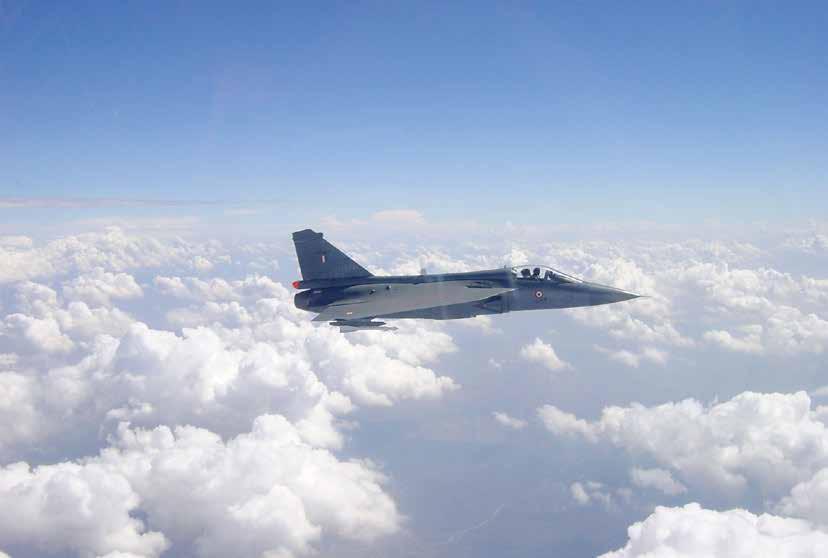
Other proposals
While clearing the Arjun project, MoD also gave its nod to some other proposals. The total amount involved is around Rs 17,000 crore, including the main battle tank project. Among the new orders is the emergency procurement of 27 M4 wheeled armoured vehicles. A Rs 178-crore contract with Bharat Forge, a company under the Kalyani group based in Pune, the M4 vehicles were tested in Ladakh during the military stand-off with China to check their ability in swiftly transporting troops in high-altitudes.
The procurement proposals cleared by defence acquisitions council (DAC) included eight ‘Arudhra’ medium-powered radars for Rs 2,800 crore, 13 ‘Namica’ tracked carriers with ‘Nag’ anti-tank guided missiles for Rs 500 crore and ‘armour piercing fin stabilised discarding sabot (APFSDS)’ practice ammunition at a cost of Rs 270 crore), among other items. All these have been developed by DRDO.
Another project cleared at an outlay of Rs 5,300 crore envisages developing onboard ‘protection and countermeasures’ for 820 armoured fighting vehicles (AFVs) against guided missiles, rockets and other projectiles. This is a ‘Make-II’ category project in which various companies would develop prototypes at their own cost for the final selection.
GRSE Lays Keel of 3rd Ship of Project 17A Advanced Stealth Frigate

Garden Reach Shipbuilders and Engineers Limited (GRSE) achieved a major milestone with ‘laying of the Keel’ of Yard 3024 a ship of the Advanced Stealth Frigate Project, P 17A. As per GRSE tradition, the Keel was laid by a senior operative Mithailal Pasi, Structural Fitter of Shipbuilding Shop at the Main Works Unit of GRSE, in the presence of Vice Admiral Sandeep Naithani, AVSM, VSM, Controller of Warship Production & Acquisition (CWP&A), Indian Navy and Rear Admiral GK Harish, VSM, Director General of Naval Design.
Rear Admiral VK Saxena, IN (Retd.), Chairman & Managing Director, GRSE, Cmde. Sanjeev Nayyar, IN (Retd), Director (Shipbuilding), Cmde. PR Hari, IN (Retd), Director (Personnel) and RK Dash, Director (Finance)and senior officials of the Indian Navy and GRSE also attended the event.
The contract for construction of three Stealth Frigates under Project 17A is the largest ever order awarded to the shipyard by the Ministry of Defence with a value of over Rs.19293 crores. The shipyard, despite all challenges amid Covid – 19 pandemic, launched 1st ship of P17A Stealth Frigate “INS Himgiri” ahead of schedule on 14th December 2020. The Keel laying of Yard 3024 has also been achieved ahead of schedule. It is important to note that the Keels for both 1st & 2nd ships viz, Yard 3022 and Yard 3023 were also laid ahead of schedule on 10th November 2018 and 24th January 2020 respectively.
The important milestones of ship building involve the process of Cutting of steel which is called the ‘Start Production’ stage followed by ‘Keel laying’ subsequent to which, the other blocks are built around the keel block. The next phase is launching, when the Ship is placed in water for the first time, Subsequently, the ship is outfitted with equipment and systems post launch, followed by trials of equipment. On completion of all trials and once the compartments are ready, the ship is delivered to customer.
P17A ships shall be the most advanced state-ofthe-art Guided Missile Frigates, 149 m long, with a displacement of approximately 6670 T and advanced CODOG Propulsion enabling speed of over 28 knots. These complex platforms are equipped with a powerful weapon & sensor package capable of neutralising threats in all three dimensions ofAir, Surface & Sub-surface. P17A Stealth Frigates are being built using Integrated Construction Methodology with enhanced pre-outfitting to enhance quality and reduce build periods. M/s Fincantieri, Italy is the Knowhow Provider for Technology Upgrade and Capability Enhancement in this project. An advanced PDM-PLM system is being implemented at GRSE to

manage the project over its life cycle. Since its takeover by the Government of India in 1960, GRSE has delivered high end warships ranging from Fast Patrol Vessels, Survey Vessels, Landing Ship Tanks, Landing Craft Utility, Fleet Tanker to Frigates and Missile/ASW Corvettes. The shipyard has made a significant advancement towards selfreliance in state-of-the-art warship design and construction and furthered ‘Atmanirbhar’ abhiyaan by achieving over 90% indigenous content onboard ASW Corvettes and Landing Craft Utility ships. Having modernised its infrastructure facilities, today GRSE is in a position to construct 20 warships concurrently using Advanced Modular Integrated Shipbuilding Technology in line with the best in the world.
GRSE’s Design Unit has been recognized by Dept. of Scientific & Industrial Research (DSIR). The complete designs of LCUs, Water Jet FACs, Survey Vessel (Large) and ASW - SWCs have been developed by the 100+ member Strong Design Team. The 3D Virtual Reality Lab at GRSE aids in identification of Design/ Construction issues at early Design Stage. GRSE has proven design capabilities to integrate systems onboard its platforms to meet specific needs of its customers.
GRSE is currently executing two more major projects of Indian Navy pertaining to construction of 04 Survey Vessel Large ships and 08 ASWSWC ships apart from the 03 P17A ships. The Shipyard also received an Export Order from Govt of Guyana for Design, Construction and Delivery of 01 Ocean Going Passenger cum Cargo Ferry Vessel and delivered FPV “SGPS Zoroaster” to Govt. of Seychelles.With proven export credentials backed by a healthy order book, the shipyard is well on its way to realise its vision of being a global leader in shipbuilding.
India & Brazil discusses collaboration in Space after successful launch of Amazonia-1 Satellite by ISRO

Dr. Jitendra Singh, Union Minister of State for Atomic Energy, Space, Development of North Eastern Region (DoNER), MoS PMO has said that India’s ascent to the World Comity of Nations will happen via Space Technology. In a virtual interaction with the visiting Brazilian Minister of Science, Technology and Innovation, Marcos Pontes, and the heads of the Brazilian Space Agency after the successful launch of Amazonia-1 satellite of Brazil by ISRO , Dr Jitendra Singh said that collaboration between the two countries mark a beginning of robust bonding and is a role model for other countries to follow. He said, the launch also marked the first dedicated mission of ISRO’s commercial arm NewSpace India Ltd. (NSIL).
Dr Jitendra Singh said, Prime Minister Narendra Modi provided a special impetus in the last 5-6 years to all the scientific pursuits including Space Technology and added that the extension of applications of Space Technology to different sectors and areas brought ‘ease of living’ for common man. He said, whether it is railways or smart cities, agriculture or disaster management, highways or defence, Space technology is contributing in a big way.
Referring to the Prime Minister’s revolutionary decision to “unlock” India’s Space Technology to private players for the first time after independence, Dr Jitendra Singh said that this will bring ‘ease of living’, ‘ease of environment’ and ‘ease of humanity’. The Minister said, while India began its Space journey much after several other countries, but today we are in a position to provide inputs from Mangalyaan and Chandrayaan to the premier institutions of the world like the NASA of the USA.
In his address, Brazilian Minister of Science, Technology and Innovation, Marcos Pontes said that India- Brazil joint venture in Space Technology will offer new opportunities for companies and will help create new jobs. He said that Amazonia-1 is an optical earth observation satellite and is intended to provide remote sensing images to observe and monitor deforestation, to improve the real-time detection system of deforestation in Brazil, especially in the Amazonia region, and to monitor the diversified agriculture throughout the country. The Minister said that the new satellite would open the door for multiple business, trade and governmental opportunities. Brazil has also requested for India’s support in procurement of material and systems for its launch vehicle programme.
MoUs and Joint Working Group (JWG): Since early 2000s, India and Brazil have signed cooperative instruments for exploration and peaceful uses of outer space, both at the government level (2004) and space agency level (between ISRO and Brazilian Space Agency AEB in 2002). In line with the provisions of the agency level MoU, JWG was formed in 2007. The JWG (reconstituted with new members) had a meeting in January 2020. Cooperation possibilities in future space science missions, utilizing ISRO’s PS4 orbital platform, space weather studies etc. were discussed
HAL Hands Over ALHs to the Indian Navy and Indian Coast Guard

HAL handed over three Advanced Light Helicopter (ALH Mk III) to Indian Navy and two ALHs to Indian Coast Guard as part of its 16 ALHs contract during Aero India 2021. The helicopters were handed over by R. Madhavan, CMD, HAL to Admiral Karambir Singh, Chief of Naval Staff and Mr. K. Natarajan, DG, Coast Guard in the presence of Defence Minister, Mr Rajnath Singh.
“The remaining helicopters from the contract are under various stages of production, flight tests and we plan to deliver all the helicopters within the contract delivery schedules despite production slowdown due to COVID restrictions” said, Mr Madhavan.
ALH has clogged close to 3,00,000 cumulative flight hours and has proven its mettle in versatile operations.
The ALH Mk III is fitted with state-of-the-art Glass cockpit and powerful Shakti engine. The contract involves integration of 19 major systems with the existing ALH MK III that include IFF MKXII & ATC Xpdr with ADS-B Out, V/UHF Communication System, Traffic Alert and Collision Avoidance (TCAS-I), SAR Homer system, Automatic Deployable Emergency Locator Transmitter (ADELT), Loud Hailer, Radio altimeter, Rescue Basket, Medical Intensive Care Unit (MICU), IADS System, AFCS, Digital Video Recording System (SSDVR), Automatic Identification System (AIS), High Intensity Search Light (HISL), Pressure Refueling System, Control grips, EO POD Rev III, Surveillance Radar System and 12.7 mm Gun system.
HAL’s LUH (Army Variant) Receives IOC

The Light Utility Helicopter (LUH) received the Initial Operational Clearance (IOC) for the Indian Army from CEMILAC during Aero India 2021 in the presence of Defence Minister, Rajnath Singh. R Madhavan, CMD, HAL said the thrust is being given by HAL for indigenous R&D programmes towards self-reliance and enhancing operational
effectiveness of Armed Forces. Arup Chatterjee, Director (Engg. and R&D), stated that, the performance of the basic helicopter in all terrains and under all weather conditions is satisfactory. HAL is currently in the phase of integrating and flight-testing mission role equipment on LUH. HAL is fully geared up to fulfill the requirements of the customers in time bound manner
The LUH is a 3-ton class new generation single engine helicopter indigenously designed and developed by Rotary Wing Research and Design Centre of HAL with features suitable for operations in the diverse operating conditions unique to India. The LUH will replace the ageing fleet of Cheetah / Chetak helicopters operated by the Services.
The LUH is powered by a single turbo shaft engine Ardiden 1U from M/s. Safran Helicopter Engine (SHE), France with adequate power margins to accomplish high altitude missions in Himalayas with ease. LUH is equipped with Smart Cockpit Display System (Glass Cockpit), state-of-the-art HUMS (Health & Usage Monitoring System) and is designed for various utility and armed roles.
All certification activities like Ground testing, Ground Test Vehicle endurance runs, system testing, Flight testing including hot weather trials, cold weather trials, sea level trials and hot weather high altitude trials have been completed. Based on the flight trials carried out, all PJSQR requirements for basic helicopter certification have been complied satisfactorily.
President Ram Nath Kovind graces valedictory function of Aero India

With 201 MOUs, product launches and technology transfers which will provide further impetus to the aerospace and defence industry of the country, Aero India 2021 concluded. The valedictory function was graced by President of India Ram Nath Kovind and First Lady Savita Kovind.
Over 600 exhibitors attended physically and another 108 in virtual mode. Around 3,000 Business2-Business meetings were conducted during the event and representatives from 63 countries were in attendance. The 13th edition of Aero India in its 25th year was organised amidst COVID-19 challenges as the world’s first ever hybrid defence and aerospace exhibition with no public days and a concurrent virtual exhibition. In his address President Ram Nath Kovind said, India is not just a market, but a land of immense opportunities for the whole world, including in the defence sector. He added that the government has taken several policy initiatives aimed at placing India among the top nations in the defence sector with twin objectives of self-reliance and export promotion. The President said that the government is focused on promoting the ‘Ease of Doing Business’ to encourage manufacturers to set up units in India. The President said that the reforms initiated in India in the last six years offer unprecedented opportunities to investors and private companies in the defence and aerospace sectors. The President said that Aero India is a living proof of India's ever-growing strength in the defence and aerospace sectors at the global level. The event has exhibited that the global confidence in India’s capabilities is growing steadily.
Defence Minister Rajnath Singh said Aero India offered a unique platform to Indian private and public sector industry and global original equipment manufacturers to forge partnerships and showcase products to potential customers. He informed that the first ever IOR Defence Ministers’ Conclave was attended by ministers and delegates from 26 countries.
Total Solution Provider for EMI/ EMC
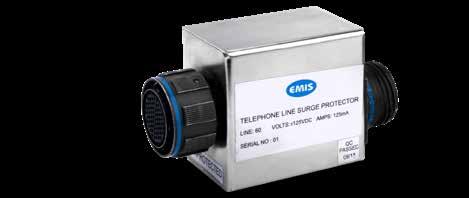
EMI Solutions Pvt Ltd is a prominent Indian company dedicated to deliver end-to-end Electromagnetic/ Radio Frequency Interference Solutions to the customers. EMIS is a part of the KSI Group that includes KS Instruments and KWK Resistors; manufacturers of Instruments Transformers and Power Resistors respectively. EMIS, founded in 1998 in Bengaluru with manufacturing & test facilities located in Bommasandra Industrial Area, Bangalore. The manufacturing facility & processes of EMIS are ISO 9001: 2015, 14001: 2015 & ZED certified.
Product range includes
• EMI/RFI Power line filters • HEMP filters Feedthrough capacitors/ filters • Coaxial EMP protectors • HEMP Ethernet filters RJ-45 / RS-422 • HEMP Telephone line / Data line filters • Tempest Filters • Power quality products • Surge & Lightning Arrestors
EMIS manufactures a complete range of EMI/RFI Power line filters in single and three phases (250V, 440V, 520V,600V) & can offer filters with current ratings up to 2500A. The products are manufactured according to International safety certifications UL, CSA/C-US & NEMKO ensuring that the products can now be exported to Europe, USA, Canada meeting stringent EMI / RFI standards CSA22.2, UL 60939-3 & IEC/EN 60939.
The EMI/ EMC test facility of EMIS is accredited by the NABL accreditation as per ISO/IEC 17025:2017 standards. It offers EMC related tests (both In-House & On-Site Testing) and provide consultancy for EMC problems in Emission and Immunity. EMIS also has a DSIR (Department of Scientific and Industrial Research, Government of India) recognised R&D Lab where customers can avail a wide range of military compliance safety testing services.
EMI Solutions Pvt Ltd. Announces a new line of EMI filters for MIL-STD-461 DC and AC single and three phase (Delta or Wye) applications. These filters are designed to mitigate conducted emissions from 10KHZ to 30MHz, while feed through (line to ground) capacitors incorporated in the filters maintain filter attenuation to 1GHz and above when installed with additional shielding and isolation between input and output terminations. Also these series of filters designed to comply with the stringent environmental requirements and conditions of Navy and Airborne applications. These filters also can be customised to meet the electrical requirements, including maximum leakage current, specified in MIL-STD-461.
EMI has two primary modes of propagation – conducted and radiated. Conducted EMI propagates through cables such as power lines, electrical wires and signal lines. Radiated interference travels through the air from sources such as appliances, motors, power supplies, cell phones and radio transmission equipment.
Features of MIL 461 Filters
• Rated Current up to 150A • Operating Frequency DC to 400Hz • MIL connector terminations • Inbuilt Feedthrough design (optional) • Design corresponding to MIL 461, UL 60939 &
CSA 22.2

Applications
• SMPS • UPS • Converters • Diesel Generators • Communication equipments
If you need more information concerning about MIL 461 EMI filter for your application or to request a quote, contact us at marketing@emisindia.com.
DRDO conducts successful flight test of Solid Fuel Ducted Ramjet
Defence Research and Development Organisation (DRDO) successfully carried out a flight demonstration based on Solid Fuel Ducted Ramjet (SFDR) technology from Integrated Test Range Chandipur off the coast of Odisha . All the subsystems, including the booster motor and nozzle-less motor, performed as expected. During the test, many new technologies were proven, including Solid Fuel based Ducted Ramjet technology.
Successful demonstration of Solid Fuel based Ducted Ramjet technology has provided DRDO with a technological advantage which will enable it to develop long range air-to-air missiles. At present, such technology is available only with a handful of countries in the world. During the test, air launch scenario was simulated using a booster motor. Subsequently, the nozzle-less booster accelerated it to the required Mach number for Ramjet operation.
The performance of the missile was monitored using the data captured by Electro Optical, Radar and Telemetry instruments deployed by ITR and confirmed successful demonstration of the mission objectives. The launch was monitored by senior scientists of various DRDO labs, including Defence Research & Development Laboratory (DRDL), Research Centre Imarat (RCI) and High Energy Materials Research Laboratory(HEMRL).
Defence Minister Rajnath Singh and Secretary Department of Defence R&D and Chairman DRDO Dr G Satheesh Reddy congratulated the scientists of DRDO,Indian Air Force and the Industry on the successful flight test of SFDR.

Turkmenistan Special Forces Commence Training at Indian Special Forces Training School
The Indian Special Forces (SF) have over a period earned immense respect and reputation of being one of the finest Special Forces in the world due to its professionalism, operational expertise, and sacrifice. Special Forces of friendly nations including the USA, Australia, countries of Central Asian Region & the Middle East have increasingly shown their desire to train with the battle-hardened Indian SF troops. In response, the Indian Army’s Special Forces have increased their engagement with their counterparts from friendly nations. Based on a request from the Turkmenistan Special Forces, the Special Forces Training School (SFTS) of the Indian Army, which is a unique institution providing training to the Indian Army’s Special Forces, has commenced training of paratroopers from the Turkmenistan Special Forces in Combat Free Fall as a precursor to a series of other customised professional courses which will assist in capability enhancement of Turkmenistan Special Forces.
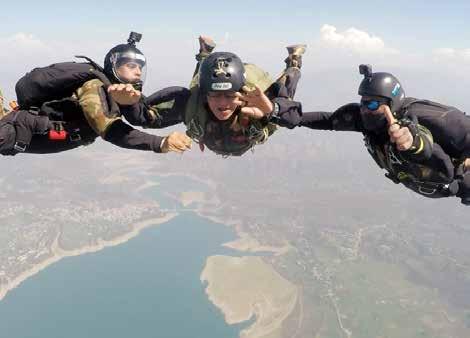
SCD to Lead Israeli Consortium for the development of novel VCSEL devices
The innovative technology will enable significant advances in performance and manufacturability, for various defense and commercial applications
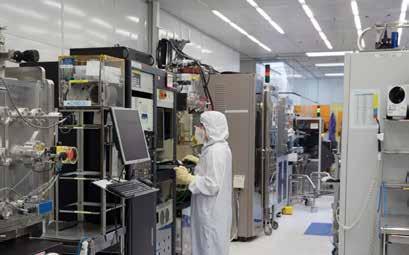
SCD - a global leader in the development and manufacture of a wide range of cooled and uncooled infrared detectors and high-power laser diodes - will lead an Israeli National Consortium for the development of next generation Vertical Cavity Surface Emitting Lasers (VCSEL). The consortium is supported by the Israeli Innovation Authority through its MAGNET Consortium program.
The VCSEL consortium has been formed by leading high-tech companies and academic institutions, including Nvidia, Civan Advanced Technologies, Galil Microwaves, the Technion – Israel Institute of Technology, and the Hebrew University of Jerusalem. The focus will be to develop technologies for three main applications: high power lasers, high speed telecommunication, and atomic clocks.
Since being industrialized in the 1990s, VCSELs have become important building blocks in various applications, such as fiberoptic data transmission and, recently, facial recognition for smartphones. When it comes to manufacturability, VCSELs offer significant advantages over traditional edge-emitting laser technologies, including the ability to process large quantities of diodes on a single wafer, enabling testing at the wafer level, and more.
With the establishment of this consortium, SCD, together with leading academic scientists in the field, intends to develop an innovative, high-power VCSEL that will enable a new paradigm in optical laser pumping for many commercial and defense applications. SCD will leverage its semiconductor expertise and long-standing history of developing and manufacturing of high-power laser diodes to develop this next generation VCSEL solution.
“We have identified VCSELs as a potential game changer in the ever-growing world of high-power lasers, for many different applications,” says Dan Slasky, CEO of SCD. “SCD, with its strong tradition of technological innovation in the IR and laser domain, is once again pioneering an innovative technology which, if successful, will result in a significant impact on the laser industry.”
Semi Conductor Devices (SCD) develops and manufactures a full spectrum of cooled and uncooled infrared detectors and laser diodes. The company’s advanced concepts and cuttingedge technologies have positioned it as one of the world’s leading sources of IR detectors. The close relationship between SCD and well-established systems houses around the world ensures that SCD’s detectors are produced in accordance with the latest requirements. SCD offers a complete range of offthe-shelf and custom-designed detectors and laser diodes in various configurations. These are typically applied in IR seekers, thermal imagers, smart munitions, night vision systems, machine vision systems, medical applications, laser rangefinders and laser designators. SCD’s detectors are designed for the entire IR spectrum – NIR, SWIR, MWIR, and LWIR.
Embraer Releases Technical Guidance for Sanitization in Commercial Aircraft
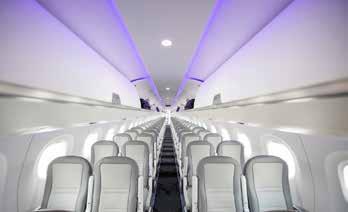
Embraer has released technical guidance to apply UV-C lights for cockpit sanitization, as well as disinfectants and coatings for the cabin in the Company’s commercial aircraft. According to these specifications, the utilization of UV-C Lights in the Flight Deck region will eliminate the COVID-19 virus. The disinfectants, compatible with the aircraft materials, were developed based on extensive testing and ease of application for all surfaces in the passenger cabin and cockpit.
“Embraer is always working on pursuit of solutions that support its customers and their operations,” said Johann Bordais, President & CEO, Embraer Services & Support. “The main goal of these guidance is to effectively eliminate or inactivate a microorganism or virus in the flight deck and the passenger cabin through an effective, yet easy procedure.”
The document includes guidance for the EMB120 Brasilia, the ERJ 145, the E-Jets, and the E-Jets E2 families of commercial aircraft. Currently, there are more than 100 customers flying a fleet of almost 2,500 Embraer commercial aircraft in more than 80 countries.
In December 2020, Embraer released technical guidance to assist customers to properly define the transportation characteristics and payload requirements for the COVID-19 vaccines when
using the Company’s commercial aircraft. The transport of these vaccines requires low temperatures, which are maintained using dry ice. An Embraer aircraft can transport over one hundred thousand vaccines, depending on the aircraft configuration and containers used. That guidance includes technical information, such as how operators can load and unload each aircraft.
Regarding Embraer’s products, the Company has released a Service Bulletin that allows ERJ 145 operators to install highefficiency particulate air (HEPA) filters, which are standard on all versions of the Embraer E-Jets and E-Jets E2 families of commercial aircraft. HEPA filters are extremely efficient, capturing 99.97% of airborne particles and other biological contaminants, such as bacteria, viruses, and fungi. This technology is also available on Embraer Executive Jets, with the HEPA filter now standard on both the Praetor 500 and Praetor 600.
Embraer has also approved the use of MicroShield360 and Bacoban, long-lasting preventive coating systems that, when applied to aircraft cabin surfaces, continuously inhibits the growth of microorganisms, viruses and bacteria. The combination of these new features, with the existing cabin environment technologies, equates to a higher level of protection for passengers.
IAI and Matrix to Establish AI Development Center for Future Battlefield

IAI's President & CEO Boaz Levy and Matrix CEO Moti Gutman, at the agreement signing.
Israel Aerospace Industries (IAI) and Matrix signed an agreement to establish a joint AI excellence center. The two companies will co-develop AI, machine learning (ML) and Big Data-driven solutions to be integrated into IAI’s satellite and space systems, defense and attack systems, missiles, homing heads, electro-optical payloads, and additional systems.
In the first stage, the development center will focus on AI-driven solutions for automated target detection on the future battlefield. The development center will seek to expand the capabilities and performance of existing systems and introduce innovative capabilities on automated systems.
IAI has been using AI capabilities in its various systems for many years. It will now leverage the development center to work with Matrix Defense on scaling existing capabilities and developing new ones. At the center both companies will create innovative analytic engines and enhanced battlefield capabilities. The joint teams will work with experts in specific fields such as satellites, missiles, strategic systems, and more, as well as content experts on AI, analytical engines, and big data.
In an age of big data, operational systems’ operators are grappling with information influx. Integrating operational scenarios and automated tools with high reliability will enhance the systems’ performance and provide a significant edge on the future battlefield.
Collins Aerospace brings next-generation sensors to FastJets

• Collins Aerospace’s MS-110 sensor features multi-spectral technology, significantly increasing intelligence capabilities and improving imagery in poor visibility • Retrofit kits available to convert Dual-Band, DB-110 sensors to multi-spectral variants
Collins Aerospace, a unit of Raytheon Technologies Corporation was awarded an Indefinite Delivery/ Indefinite Quantity (IDIQ) contract modification by the US Air Force for its newest Fast-Jet reconnaissance pod, the MS110 Multispectral Airborne Reconnaissance system.
The newer MS-110 is a step-change advancement in Airborne Reconnaissance capability and provides capabilities that are unmatched by targeting pods or sensors internally fitted inside the aircraft body. These capabilities include: • Highest resolution imagery achievable at long/stand-off range for peacetime cross border surveillance or highthreat wartime scenarios • Advanced multispectral imagery (color and false-color composites) to detect targets with a higher degree of confidence or through poor weather/atmospheric conditions • Wide-area coverage in high resolution • Flexible planning/re-tasking for real-time changes in dynamic operational situations by aircrew • SCi-Toolset, a suite of software to help End Users extract critical intelligence from the MS-110’s imagery
“The combination of spatial and spectral resolution modalities provides customers with an exponential increase in intelligence
gathering capabilities against challenging targets,” said Kevin Raftery, vice president and general manager, ISR and Space Solutions for Collins Aerospace.
Collins Aerospace Systems, a unit of Raytheon Technologies is a leader in technologically advanced and intelligent solutions for the global aerospace and defense industry. Collins Aerospace has the extensive capabilities, comprehensive portfolio and broad expertise to solve customers’ toughest challenges and to meet the demands of a rapidly evolving global market.
Raytheon Technologies Corporation is an aerospace and defense company that provides advanced systems and services for commercial, military and government customers worldwide. With 195,000 employees and four industry-leading businesses Collins Aerospace Systems, Pratt & Whitney, Raytheon Intelligence & Space and Raytheon Missiles & Defense the company delivers solutions that push the boundaries in avionics, cybersecurity, directed energy, electric propulsion, hypersonics, and quantum physics.
Anew technological center dedicated to developing and producing non-GPS navigation systems was recently launched by the Directorate of Defense Research & Development (DDR&D), part of Israel's Ministry of Defense (IMOD), and Israel Aerospace Industries (IAI). In the new center, IAI will develop and manufacture highly-accurate inertial sensors. These sensors will enable the production of next generation navigation systems, and will significantly increase their performance and capabilities.
The innovative navigation sensor technology is founded on unique Israeli innovation based on years of research and collaboration between DDR&D and IAI. These sensors will be implemented in various operational systems within Israel's defense systems, thus enabling Israel to maintain its qualitative advantage and to continue to address the challenges of the modern battlefield.
Brig. Gen. Yaniv Rotem, Chief of R&D at UMOS DDR&D, said, “In launching the new compound, DDR&D demonstrates our position at the forefront of technology and its contribution to Israel's technological independence. The extensive know how and experience accumulated at DDR&D and TAMAM, our partners, allowed us to challenge ourselves with this new endeavor and accomplish something impressive. The follow-up program is just
IMOD DDR&D and IAI Inaugurate Advanced Navigation Technology Center

as challenging and we plan to work diligently until we prove the new capability in the various applications and in collaboration with IDF units.”
Avi Elisha, IAI’s TAMAM Division GM, said, “Our partnership with IMOD DDR&D dates back many years. We work together to achieve the ongoing enhancement of the innovative navigation systems for Israel. The new center we launched will allow highly accurate navigation capabilities with IAI’s unique technologies. Only a handful of countries have this technology, which is a game-changer in the field of inertial navigation.”
The new navigation technology center established at TAMAM, IAI’s electro-optics and navigation house in IAI’s Systems Missiles and Space Group, represents decades of experience in developing navigation systems.
ALLTEC Composite Material of Brazil and Rafael Advanced Defense Systems of Israel signed a Memorandum of Understanding (MoU) for cooperation on passive addon armor solutions, their maintenance and life cycle support.
Rafael’s Add-On Reactive Armor and Passive Armor defends against a wide range of threats such as anti-tank rockets, small firearms, AP projectiles, high-speed fragments of artillery, mortars, and high explosives.
Under this MoU, ALLTEC and Rafael will cooperate on business opportunities and projects for the supply of passive add-on armor solutions from STANAG Level 4 and above, its maintenance and life cycle support for the Brazilian Ministry of Defense and auxiliary forces.
The MoU's purpose is to achieve maximum local industrial content and facilitate joint marketing and sales of Rafael’s passive add-on armor solutions, including maintenance and life cycle support for Rafael's Products.
For over 30 years, Rafael’s add-on armor protection solutions have been in use by the Israel Defense Forces, US forces, NATO countries, peacekeeping units, and other customers around the world to effectively protect land forces.

ALLTEC of Brazil and Rafael sign MoU on Add-On Armor Solutions
Rafael’s Add-On Reactive Armor and Passive Armor (easily installed or removed quickly according to mission needs), defend against a wide range of threats such as anti-tank rockets, small firearms, AP projectiles, high-speed fragments of artillery, mortars, and high explosives.
ALLTEC's vast knowledge and experience in this field have positioned it as a technological leader in the manufacture of ceramic armored shields (add-on) in any shape and thickness. ALLTEC has used these expertise to increase the level of ballistic protection required by the Brazilian Army on the new Wheeled Armored Personnel Carrier (WAPC) ‘Guarani’.
ALLTEC was designated as a contractor to develop a full kit of additional ballistic protection (add-on) to be attached to the new WACP ‘Guarani’, including the stages of technological research, manufacturing, proving ground tests, official certification process, final assembly and camouflage painting of the armored shields.
This innovative challenge has resulted in the acquisition of deep knowledge and a mastery of technology to manufacture armored ceramic shields (add-on) which have qualified ALLTEC as the main supplier to the Brazilian Army for that equipment.
Elbit Systems Awarded $300 Million Contract to Supply Hermes 900 UAS to an Asian Country

Elbit Systems Ltd. has been awarded an approximately $300 million contract by a country in Asia to provide HermesTM 900 Unmanned Aircraft Systems (“UAS”). The contract will be performed over a period of five years.
Under the contract, the Company will provide its Hermes 900 UAS and associated sub-systems, as well as maintenance and support services. The Hermes 900 UAS has been selected to date, by 12 countries, attesting to its competitive edge that combines technological sophistication, reliability, open architecture and a solid growth path.
Bezhalel (Butzi) Machlis, Elbit Systems President & CEO, commented: “There is a continuous demand for integrating unmanned systems to cope with a growing variety of operational needs. Our operational portfolio of autonomous capabilities, in all domains of operation, positions us competitively to address these needs.”
Elbit Systems Ltd. is an international high technology company engaged in a wide range of defense, homeland security and commercial programs throughout the world. The Company, which includes Elbit Systems and its subsidiaries, operates in the areas of aerospace, land, and naval systems, command, control, communications, computers, intelligence surveillance and reconnaissance ("C4ISR"), unmanned aircraft systems, advanced electro-optics, electro-optic space systems, EW suites, signal intelligence systems, data links and communications systems, radios, cyber-based systems and munitions.
BEML Limited, a ‘Schedule A’ company under the Ministry of Defence (MoD) received export orders from Cameroon and Bangladesh under Government of India-Lines of credit.
The order for Cameroon has been received from Ministry of Economy, Planning & Regional Development (MOEPRD), Government of Cameroon for supply of 71 units of construction equipment consisting of Bulldozers, Excavators, Wheel Loaders, Motor graders and Compactors for their Cassava Farm Project.
The order for Bangladesh has been received from Ministry of Roads & Highways Department, Government of Bangladesh for supply of construction equipment consisting of Wheel Dozer for their construction, Repair and Maintenance of Road and Infrastructure projects in Bangladesh.
Valuing at around USD 23 Million, this equipment will be having more than 90% indigenous content and will be manufactured at BEML’s KGF and Mysore plants in Karnataka signifying the true spirit of ‘Atmanirbhar Bharat’ with thrust on going global.
BEML Limited is a leading multi-technology company, which plays a pivotal role in serving India’s core sectors like Defence, Rail, Power, Mining and Construction by offering world class products. BEML operates in three verticals viz. Defence & Aerospace, Mining & Construction and Rail & Metro and has state-of-the-art manufacturing facilities located at Bangalore, Kolar Gold Fields (KGF), Mysore, Palakkad. BEML has very strong R&D infrastructure with a nationwide network of sales and services.
BEML bag orders from Cameroon & Bangladesh

KAI and IAI sign MOU for Manned & Unmanned Teaming Systems

Korea Aerospace Industries (KAI) and Israel Aerospace Industries (IAI) have signed a Memorandum of Understandings (MOU) for collaboration in which the companies will offer the Republic of Korea (ROK) military forces with unmanned Loitering Munitions systems. As part of the MOU, KAI and IAI are aiming to expand their long cooperation to market the loitering munitions to ROK Army requirements.
KAI’s President & CEO, Hyun-ho Ahn expressed the importance of partnership between IAI and KAI which have been lasted for last decades for many programs including defense and commercial projects. Through the combination of domestic aircraft technology and IAI’s excellent unmanned aerial system technology, IAI and KAI would provide a foothold for innovation, such as strengthening the defense power of the Republic of Korea and commercializing exports in the future. Mr. Ahn emphasized that KAI is pleased to initiate the collaboration dialogue with IAI team in earnest through these MOUs.
IAI’s President & CEO, Boaz Levy said- “The MOU’s singed today is another milestone in our growing collaboration with KAI. IAI has long relations with the ROK and the local industries and we are happy to join KAI, one of Korea’s leading companies to explore future opportunities. Combining IAI’s proven capabilities in loitering munitions and KAI’s technologies and products to create an opportunity for an improved solution to the future battlefield”.
Pratt & Whitney Canada’s PW800 Engine Achieves New Milestone with Falcon 6X Business Jet
Pratt & Whitney Canada, a business unit of Pratt & Whitney, a division of Raytheon Technologies Corp. (NYSE: RTX), announced that its award-winning PW800 engine has achieved a new milestone with the first flight of the Falcon 6X business jet, powered by PW812D engines, from Dassault’s assembly centre in Bordeaux-Mérignac, France.
“The PW812D engine for the Dassault Falcon 6X features the latest innovations and technologies,” said Maria Della Posta, president of Pratt & Whitney Canada. “We are thrilled with the engine’s performance and proud to have it powering the Dassault Falcon 6X, building on our successful relationship with Dassault over the past 20 years of active programs.”
The PW800 is the most modern, efficient and environmentally responsible engine in its class. Using the most sustainable and high-performance technologies, the engine offers double-digit improvements in fuel burn, emissions, maintenance times and noise. The PW800 engine also incorporates the latest generation of technologies in every aspect, from advanced design to innovative maintenance functionality. For passengers, the engine is designed to provide an unmatched experience with an exceptionally quiet and comfortable cabin making it the quietest engine in its class.
Rafael and IMDO Completes Advanced Tests of Iron Dome System
Rafael Advanced Defense Systems and the Israel Missile Defense Organization (IMDO) in the Israel Ministry of Defense, have successfully completed a test campaign of the Iron Dome Weapon System (IDDS). This campaign, along with two recent Iron Dome tests, demonstrated a significant upgrade of the system’s technological capabilities. The Iron Dome was tested through a range of complex scenarios and successfully intercepted and destroyed targets, simulating existing and emerging threats, including the simultaneous interception of multiple UAVs, as well as a salvo of rockets and missiles.
This campaign took place in a testing site in southern Israel, with the participation of IAF soldiers. The new version of the Iron Dome system will be delivered to the IAF and the Navy for operational use and will strengthen Israel’s multi-tier missile defense capabilities.
The prime contractor for its development is Rafael Advanced Defense Systems Ltd. under the IMDO in the Israeli Ministry of Defense. The system’s MMR radar is developed by ELTA, a subsidiary of Israel Aerospace Industries (IAI), and the Battle Management Center (BMC) is developed by Rafael and mPrest, a Rafael subsidiary.
With over 2,500 combat interceptions, at a success rate of 90%, Iron Dome's development began in December 2007. Iron Dome serves as highly mobile, dual mission systems, designed to defeat Very Short Range (VSHORAD), as well as rocket, artillery and mortar (C-RAM) threats, aircraft, helicopters, UAVs, PGMs, and cruise missiles. Iron Dome's development has continued throughout the years, and its capabilities today include wider coverage, a broader spectrum of threat interception, the ability to handle very high volume salvos, and much more.


The Ambassador of Kazakhstan to India, Yerlan Alimbayev with the Defence Secretary, Dr. Ajay Kumar, in New Delhi.
Honeywell Automation names Ganesh Natarajan as Chairman
Honeywell Automation India Limited (HAIL NSE: HONAUT) announced Dr. Ganesh Natarajan’s appointment as Independent Director (Non-Executive) and Chairman of its Board of Directors, effective March 8, 2021. As Chairman of Board of Directors, Dr. Natarajan will offer guidance to HAIL’s management team on the company’s overall strategy, business, and financial matters. He will provide direction and Board support for strong corporate governance.
Dr. Natarajan succeeds Suresh Senapaty, who completes his fiveyear tenure as Independent Director and Chairman of HAIL on March 7, 2021.
INS KARANJ - 3rd Kalvari Class Submarine commissioned at Naval Dockyard, Mumbai
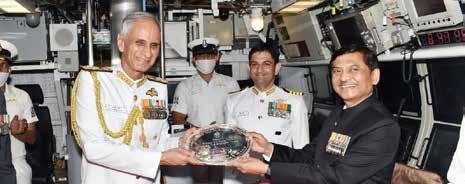
Vice Adm Narayan Prasad, Retd, CMD of Mazagon Dock limited handing over a memento to Adm Karambir Singh, CNS inside the Submarine
Major milestone for Indian Navy’s Project 75 as India achieves AatmaNirbharta with indigenous submarine construction at Mazagon Dock Indian Navy’s third stealth Scorpene class Submarine INS Karanj has been commissioned at the Naval Dockyard Mumbai through a formal commissioning ceremony. Admiral VS Shekhawat PVSM, AVSM, VrC (Retd), former Chief of the Naval Staff, who was part of the commissioning crew of the old Karanj and later the Commanding officer during the 1971 Indo – Pak war, was the Chief Guest for the ceremony. Six Scorpene Class submarines are being built in India by the Mazagon Dock Shipbuilders Limited (MDL) Mumbai, under collaboration with M/s Naval Group, France. INS Karanj would form part of the Western Naval Command’s Submarine fleet and would be another potent part of the Command’s arsenal. Admiral Karambir Singh, Chief of the Naval Staff, and other senior officers from the Indian Navy and MoD were amongst the several dignitaries who witnessed the ceremony. Crew of the erstwhile ‘Karanj’, a Russian origin Foxtrot Class Submarine which was decommissioned in 2003 were also special invitees for the ceremony. During his address, the CNS said “this impetus to Indigenisation & AatmaNirbharBharat is a fundamental tenet of Indian Navy’s growth story and future operational capabilities”.
The Chief Guest Admiral Shekhawat also highlighted India’s push towards AatmaNirbharta by saying “we live in an India launching numerous satellites, building nuclear submarines, manufacturing vaccines for the worlds - the new Karanj is another example of it”
This year is being celebrated as the ‘Swarnim Vijay Varsh’ which marks 50 years of 1971 Indo – Pak war. Old INS Karanj, commissioned on 04 Sep 1969 at Riga in the erstwhile USSR, also took active part in the conflict under the Command of then Cdr VS Shekhawat. In recognition of the valiant action of her officers and crew, a number of personnel were decorated, including award of Vir Chakra to the then Commanding Officer Cdr VS Shekhawat. Interestingly, the commissioning Commanding Officer of the old INS Karanj Cdr MNR Samant later on became the first Chief of The Naval Staff of the newly formed Bangladesh Navy in the year 1971.
The Scorpene Submarines are one of the most advanced conventional submarines in the world. These platforms are equipped with the latest technologies in the world. More deadly and stealthier than their predecessors, these submarines are equipped with potent weapons and sensors to neutralise any threat above or below the sea surface.
The induction of Karanj is another step towards the Indian Navy, consolidating its position as a builder’s Navy, as also is a reflection of MDL’s capabilities as a premier ship and submarine building yard of the world. Project – 75 also marks a critical milestone in the Yard’s continued importance in the field of Defence Production.

JSC “OKB KP”: Keeping pace with the times, not forgetting the past

Uraev Nikolay
General Director of OKB KP
The history of your enterprise begins in the early fifties of the twentieth century. Is your rich past reflected in your current activities? - Our company started its activities in 1958. In fact, JSC “OKB KP” was created for the Soviet Space Program and is one of the key developers of cable products in the country. Wires and cables for special purposes for space, airborne wires for aircraft and helicopters, control cables for submarines. The “Mir” orbital station was fully equipped with our products.
There are many such examples: from the cable for the ignition of the Olympic flame in Moscow in 1980 to the load-carrying cable on which the cosmonaut Leonov went into outer space for the first time in the world.
In the Soviet era, the Special Design Bureau of the cable industry employed 4,000 people. It was a pilot production. The scientific potential here has been and remains at a high level. This is a very rich legacy.
Does the company conduct research and development taking into account modern requirements? How has the market for such a narrow sphere in scientific and industrial activities changed? - JSC “OKB KP” maintains the full cycle: from development to serial production, including the Test Center, the whole Department and more than 5 scientific departments are engaged in research activities.
There is the development of new products of cable and wire products for special purposes for extreme and unique operating conditions. Scientists create and modernize designs, improve technologies for the manufacture of radio frequency and optical cables intended for use in telecommunications, information communication and radar systems, in communication and control systems for land, sea, aviation and space objects. Our design bureau is working on the development and production of the latest lightweight cable products that improve the tactical and technical characteristics of aircraft and spacecraft, rockets and ground vehicles.
At the same time, to maintain and strengthen scientific and production potential, we are seriously engaged in personnel policy together with leading specialized universities, such as: National Research University “Moscow Power Engineering Institute”, The Bauman Moscow State Technical University, D. Mendeleev University of Chemical Technology of Russia, National Research Tomsk State University, providing JSC “OKB KP” with young scientific personnel.
The market has brought with its component a sharp competition between enterprises for the consumer. According to the available data, the plant successfully withstands it, how does it manage? - Many years of experience and continuous improvement of technological processes, innovative developments, modern equipment and highly qualified specialists of JSC “OKB KP” ensure products of the highest quality and reliability. The enterprise is actively developing and renewing itself, preserving and increasing the accumulated experience. JSC “OKB KP” has a unique full production cycle, from development to serial production of cable products. At the same time, elements of their own research work are used. The plant's designers have created and are producing more than five thousand items of cable products. The company's catalog contains radio frequency, fiber-optic, high-voltage cables, on-board wires for general industrial and extreme operating conditions. We pay attention to product quality issues.
In the cable industry, the problem of counterfeits is more acute than anywhere else. How relevant is it for you and do you take part in its solution? - It is truly relevant, and we are aware of the severity of possible consequences. We try to warn users of our products about possible problems associated with the purchase of non-certified wires and cables, since, in this case, no one except the end user will be responsible for noncompliance in the operation of products with the established requirements. And, even despite the lower cost, we urge not to use unlicensed products for the production and repair.
Is there an entrance to the foreign market and what are the plans of the enterprise management for its development? - Previously, the products of domestic enterprises, like ours, were distributed throughout the world. Now, for example, we are negotiating with partners from India and China. Globally, there is the prospect of working with India. A lot of our equipment is supplied there, in which our wires are present.
The enterprise "Special Design Bureau of the Cable Industry" manufacture products, not only competitive but also meet international standards. It is unique, having no analogues in their field. Nikolay Uraev, General Director of JSC “OKB KP”, spoke about the impact of the long history on today's activities and the prospects of the research and production association.

Prime Minister Hands over Arjun Main Battle Tank (MK-1A) to Army
The Prime Minister, Narendra Modi handed over the Arjun Main Battle Tank (MK-1A) to the Army.
Prime Minister has said India has undertaken a massive effort to become self-reliant in the defence sector. This is inspired by what Mahakavi Subramaniya Bharathi writing in the oldest language in the world,Tamil, said Let us make weapons; let us make paper. Let us make factories; let us make schools. Let us make vehicles that can move and fly. Let us make ships that can shake the world. One of the two defence corridors is in Tamil Nadu. The corridor has already received investment commitments over Rupees Eight thousand one hundred crores.
He said that Tamil Nadu is already the leading automobile manufacturing hub of India. Now, Tamil Nadu evolving as the Tank manufacturing hub of India. On MBT Arjun Mark 1A, the Prime Minister declared “I am proud to handover the indigenously designed and manufactured “Main Battle Tank Arjun Mark 1A”. It also uses indigenous ammunition. A tank made in Tamil Nadu will be used in our northern borders to keep the nation safe. This showcases India’s united spirit – Bharat’s Ekta Darshan”
The Prime Minister said that the focus on making India Aatmanirbhar in the defence sector will keep moving with full speed.
Our armed forces signify India’s ethos of courage. They have shown time and again that they are fully capable of protecting our Motherland. Time and again they have also shown India believes in peace. However, India will protect our sovereignty at all costs, the Prime Minister said. The Prime Minister paid homage to the Pulwama attack martyrs on the anniversary of the attack today. He said “We pay homage to all the martyrs we lost in that attack.We are proud of our security forces.Their bravery will continue to inspire generations.”
U-UAP Successfully Completes Training of Indian Mi-171A2 Pilots

The Ulan-Ude Aviation Plant Training Center under the Russian Helicopters holding company (part of the Rostec State Corporation) has successfully completed training a second group of foreign specialists studying to operate and maintain the Mi-171A2 helicopter. The pilots and engineering staff of the Indian company Sky One Airways Ltd were trained in two groups.
The foreign experts studied the aerodynamics of the Mi-171A2, its design and technical operation, avionics, the VK2500PS-03 engine with its integrated digital control system and the auxiliary power unit. Each of the Sky One Airways LTD personnel received an established certificate for passing the training. Among the trainees there were also specialists from the Indian Directorate General of Civil Aviation, who conducted a preliminary inspection of the training center for its validation. "During crew training, special attention is paid to the procedure and rules for operating cockpit systems and avionics, various details concerning piloting techniques, aerodynamics and dynamics of the helicopter flight, as well as crew resource management (CRM) and airborne communications. Along with the theoretical part of the program, each technical specialist also passed practical training in operational and routine maintenance," said the Managing Director of U-UAP Leonid Belykh.
The training program for Indian pilots included additional focus on operating procedures in non-standard and emergency situations, as well as for maneuvering the helicopter out from a difficult spatial position.











SWISS PRECISION
since 1916


WE HELP YOU MANAGING AVIONICS PRODUCT OBSOLECENSE
THOMMEN specializes in offering customized aftermarket display solutions. We provide tailored replacements for legacy CRT or LCD cockpit and mission displays which are no longer supported or serviceable. We offer in-house lamination and assembly services.
THOMMEN’s Air Data Computer and Displays meet the requirements for multiple platforms and work in conjunction TAWS, ACAS/TCAS, EGPWS, FMS systems, and ADS-B transponders. Perfect avionics system integration per configurable ARINC429 and analogue in-/outputs. Several case design options (ARINC408, 3 ATI), rugged design, variety of pneumatic adapters and installation kits. Optionally RVSM, angle of attack, supersonic. NVIS compliant. No re-calibration required.
AC32 /AD32 Air Data System Upgrades
TSO-C106 (air data computer) / TSO-C10b (altimeter) / TSO-C88a (altitude encoder) / DO-160D / DO-178B Level A
THOMMEN AIRCRAFT EQUIPMENT Ltd. is a leading manufacturer of Mission Equipment, Displays, Air Data Displays and Air Data Computers, Digital Clocks and Chronographs for Helicopters, Fixed Wing Aircraft & UAV. Contact us to learn more!
THOMMEN AIRCRAFT EQUIPMENT Ltd.
Hofackerstrasse 48 | 4132 Muttenz Switzerland sales@thommen.aero www.thommen.aero Tel.: +41 61 965 22 22



